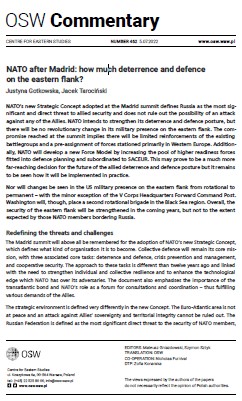NATO after Madrid: how much deterrence and defence on the eastern flank?
NATO after Madrid: how much deterrence and defence on the eastern flank?
Author(s): Jacek Tarociński, Justyna Gotkowska
Subject(s): International relations/trade, Security and defense, Military policy, Peace and Conflict Studies, Russian Aggression against Ukraine
Published by: OSW Ośrodek Studiów Wschodnich im. Marka Karpia
Keywords: NATO; NATO-Russia Founding Act; Eastern flank; US presence in the Baltic and the Black Sea region; NATO Summit in Madrid;
Summary/Abstract: NATO’s new Strategic Concept adopted at the Madrid summit defines Russia as the most significant and direct threat to allied security and does not rule out the possibility of an attack against any of the Allies. NATO intends to strengthen its deterrence and defence posture, but there will be no revolutionary change in its military presence on the eastern flank. The compromise reached at the summit implies there will be limited reinforcements of the existing battle groups and a pre-assignment of forces stationed primarily in Western Europe. Additionally, NATO will develop a new Force Model by increasing the pool of higher readiness forces fitted into defence planning and subordinated to SACEUR. This may prove to be a much more far-reaching decision for the future of the allied deterrence and defence posture but it remains to be seen how it will be implemented in practice. Nor will changes be seen in the US military presence on the eastern flank from rotational to permanent – with the minor exception of the V Corps Headquarters Forward Command Post. Washington will, though, place a second rotational brigade in the Black Sea region. Overall, the security of the eastern flank will be strengthened in the coming years, but not to the extent expected by those NATO members bordering Russia.
Series: OSW Commentary
- Page Count: 9
- Publication Year: 2022
- Language: English
- Content File-PDF

